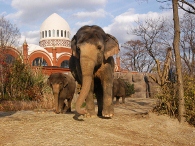|

|
Stephen Intille, Ph.D. Towards Population Scale Measurement of Physical Activity and Sedentary Behavior Mobile phones are increasingly capable of measuring behavior using sophisticated, real-time information processing using internal sensors in the phone, such as accelerometers and GPS, and external sensors that communicate with phones using wireless networks. We have developed a system for continuous remote measurement of physical activity using portable wireless accelerometers and common mobile phones. The system permits not only data collection, but also automatically-detected, event-triggered prompts to encourage compliance. The system can support the development of prototype interventions that respond to physical activity or sedentary behavior immediately after it is measured by the mobile phone system. In this talk, challenges encountered when developing the system will be described, as well as the steps we have taken to overcome them. These challenges include dealing with noisy sensors to automatically detect certain types of physical behaviors, interface design considerations when developing for long-term wearability, power-management issues on mobile devices, and effective remote management and interpretation of data and subject behavior as a study is running. |

|
Karen Adolph, Ph.D. Learning To Move A central issue for research in clinical science, movement science, and psychology is how movements are generated and controlled. I address this issue by asking how infants solve the problem of moving. Recent work shows that basic motor skills such as looking, reaching, and walking do not simply appear as the result of maturation. Rather, motor skills are learned over months or years of practice. Learning entails discovering new forms of movements, using perceptual information to select movements adaptively and to modify movements prospectively, and honing motor skills to make them more fluent and efficient. How do babies do it? One clue is that infants acquire immense amounts of variable, distributed practice with basic motor skills. A second clue is that the learning process is geared toward flexibility rather than rote performance. Infants are “learning to learn” rather than acquiring fixed solutions. The process does not end after infancy. Learning to learn is a
life-long endeavor of matching ongoing actions to the changing constraints of the body and environment.
|










